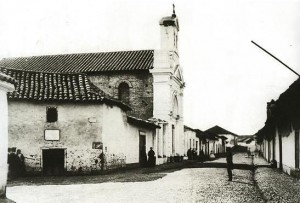
Iglesia de la Veracruz en calle Lastarria, 1895. Iglesia de la Vera Cruz. Pequeña joya patrimonial en la historia de Chile.
Popular legend says that in the place where the Church of la Vera Cruz is located, at one point there was the site that the conquistador Pedro de Valdivia had built for staying in Santiago, thus marking the start of the settlement of the “Christian Civilization” in Chilean territory.
Such legend has never been verified, there is even talk that there are documents stating to the contrary, however, in 1847 it turned out to be very useful for reestablishing the relations between Chile and Spain after the Independence process, even though the attempts to tie links dragged on since 1844 when the Spanish Crown recognized Chile as an independent country.
In 1847, the representative of Queen Isabel II of Spain, Salvador de Tavira y Acosta arrives to Chile and brings with him the peace treaty between both nations. His task was additionally to consider strengthening the ties between both countries even further.
This fraternal environment continued to grow and Tavira managed to have the Chilean people feel gratitude towards the conquistador and founder of the nation. Then, in 1852, through a unanimous agreement and taking on the proposal made by Archbishop Rafael Valdivieso, the Municipality of Santiago decides to give homage to the conquistador, perpetuating and dignifying his memory, thereby building a chapel in the mythical site.
The temple is built with fiscal funds and with the economic aid of the Spanish government. The construction is entrusted to the French architect Claude-François Brunet des Baines, who dies in 1855 and the architect Fermín Vivaceta concludes the work that lasted until 1857.
The design of this chapel includes the transfer of the image of the Señor de la Vera Cruz that was donated by Carlos V to the Church of la Merced in the XVI Century, with a relic belonging to the cross where Jesus was crucified. This is why the church was called Vera Cruz (the True Cross).